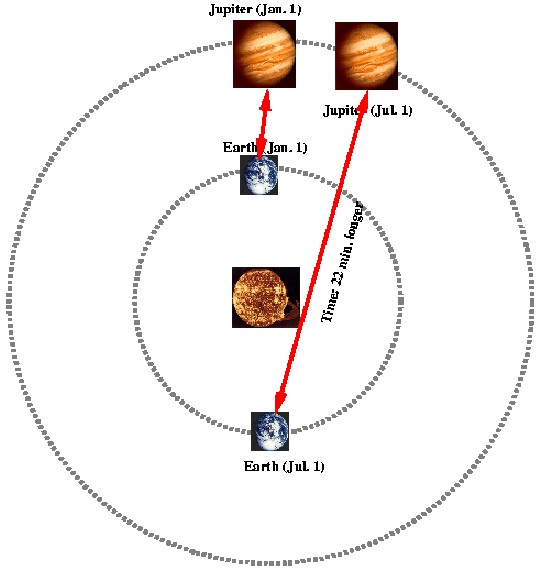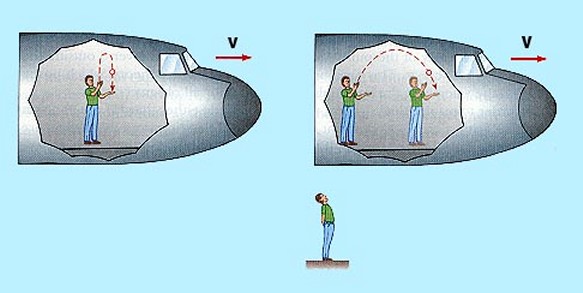
|
Main Topics > Special and General Relativity > Speed of Light and the Principle of Relativity
Logically, one would expect the ultimate cosmic speed limit to be infinity, which after all is defined as the biggest number imaginable. However, in our universe, the relatively modest speed of 300,000 kilometers per second, the speed of light, is the de facto maximum speed, and in practice, one can never catch up with a beam of light. It was the 16-year-old Albert Einstein who first gave serious consideration to why this might be the case, in the final years of the 19th Century. The speed of light had been measured often and very accurately, going back to the Danish astronomer Ole Rømer (or Roemer) who had shown in 1675 that light travels at a finite (although very high) speed. Rømer’s observations of the moons of Jupiter yielded a speed of light of about 225,000 km/s, although subsequent, more accurate, experiments have actually shown it to be 299,792,458 meters per second (about 300,000 km/s).
In 1868, the equations of the Scottish mathematician and physicist James Clerk Maxwell, building on the earlier work of Ampère, Coulomb and Faraday, noted that all electromagnetic waves traveled at exactly the same speed as light in empty space, and that light itself was a kind of wave rippling through the invisible magnetic and electric fields. Maxwell concluded that light and other electromagnetic waves should travel at a certain fixed speed relative to some unconfirmed ambient medium he called “aether”. The famous Michelson-Morley experiments of 1887, in a failed attempt to prove that light travels through a medium known as aether, had unexpectedly demonstrated that light travels at the same speed regardless of whether it was measured in the direction of the Earth’s motion or at right angles to it. At least this is the case when light travels through a vacuum: when light moves from medium to medium (like from air to glass, for example), its speed can of course change depending on the new medium's index of refraction, and this “bending” of light is essentially how lenses work, as had long been understood. Thus, whether a source of light is moving towards you or away from you, the light still travels at a steady 300,000 km/s, completely contrary to classical physics and common sense. It was the young Einstein's genius to explain just WHY the speed of light is constant and does not depend on the speed of its source or its observer. In 1905, Einstein (and also the French mathematician Henri Poincaré, who was coming to similar conclusions at around the same time, although from a more mathematical point of view) realized that the whole idea of aether as a medium for light to travel in was totally unnecessary, providing, as we will see, that one was willing to abandon the idea of absolute time. Einstein also realized that Maxwell’s equations led to an apparent paradox or inconsistency in the laws of physics, because it suggested that if one could catch up to a beam of light one would see a stationary electromagnetic wave, which is an impossibility. Einstein hypothesized, therefore, that the speed of light actually plays the role of infinite speed in our universe, and that in fact nothing can ever travel faster than light (and certainly that nothing in the universe could ever travel at anything like infinite speed). It should be noted that Einstein did not actually PROVE the constancy of the speed of light in all frames of reference. Rather, it is an axiom (an underlying assumption) from which he derived the rest of his theory. The axiom can be experimentally verified, but it is not proven in any theoretic sense. The constant speed of light was to become one of the two main planks of his Special Theory of Relativity, which we will examine in more detail in the next section. The other main plank was the "principle of relativity" (or "principle of invariance"), an idea first stated by the great Italian physicist Galileo Galilei as early as 1632. Galileo argued that the mechanical laws of physics are the same for every inertial observer (those moving uniformly with constant speed in a straight line), and therefore that, purely by observing the outcome of mechanical experiments, one cannot distinguish a state of rest from a state of constant velocity.
Galileo used the example of a ship traveling at constant speed, without rocking, on a smooth sea, and he noted that any observer doing experiments in a dark room below deck would not be able to tell whether the ship was moving or stationary. As a slightly updated example, a ball thrown in an airplane flying at 800 kilometers per hour 12,000 meters above the Earth follows the same path, and is indistinguishable from, one thrown in the airplane at rest on the ground. When he combined the principle of relativity with the constant speed of light, it became clear to Einstein that the speed of light was also independent of the speed of the observer (as well as of the speed of the source of the light), and that everyone in the universe, no matter how fast they were moving, would always measure the speed of light at exactly the same 300,000 km/s.
|
Back to Top of Page
Introduction | Main Topics | Important Dates and Discoveries | Important Scientists | Cosmological Theories | The Universe By Numbers | Glossary of Terms | A few random facts | Blog | Gravitational Lensing Animation | Angular Momentum Calculator | Big Bang Timeline
NASA Apps - iOS | Android
The articles on this site are © 2009-.
If you quote this material please be courteous and provide a link.
Citations | Sources | Privacy Policy

